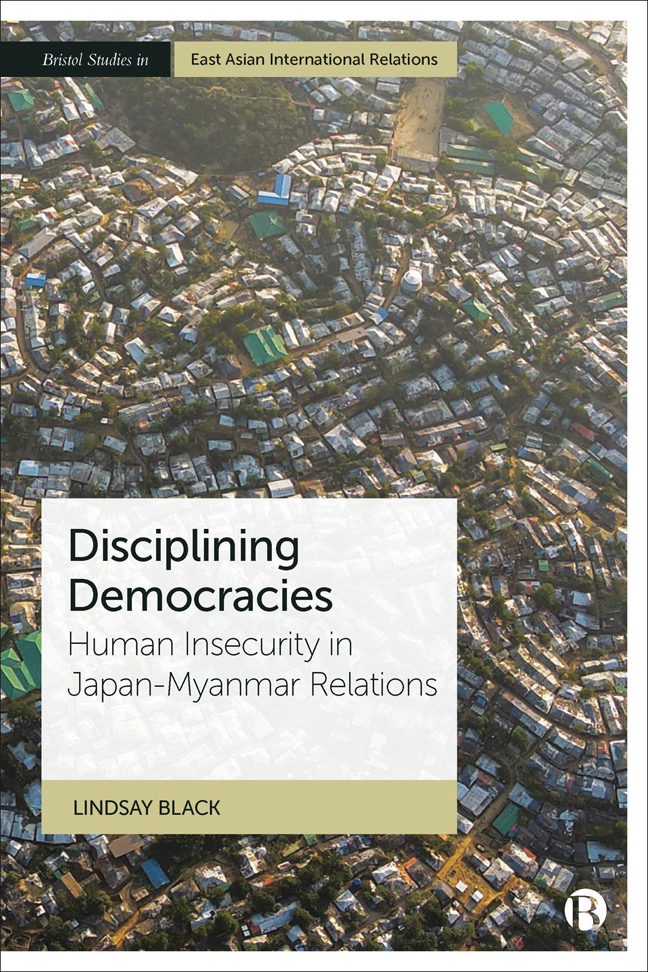Book contents
- Frontmatter
- Dedication
- Contents
- List of Abbreviations
- Acknowledgements
- Introduction
- 1 The Evolution of New Area Studies
- 2 ‘Asia's Liberal Leader’ and Human Insecurity
- 3 Japan as a ‘Bridge’: Facilitating Myanmar's Transition to a ‘Disciplined Democracy’
- 4 Japan and Special Economic Zones in Myanmar
- 5 Meddling for Profit: Japan's Peace-building Role in Myanmar
- 6 Dereliction of Responsibility: Japan's ‘Liberal Leadership’ in the 2016–20 Rakhine Crisis
- Conclusion: The Chimera of Progress
- Notes
- References
- Index
3 - Japan as a ‘Bridge’: Facilitating Myanmar's Transition to a ‘Disciplined Democracy’
Published online by Cambridge University Press: 25 January 2024
- Frontmatter
- Dedication
- Contents
- List of Abbreviations
- Acknowledgements
- Introduction
- 1 The Evolution of New Area Studies
- 2 ‘Asia's Liberal Leader’ and Human Insecurity
- 3 Japan as a ‘Bridge’: Facilitating Myanmar's Transition to a ‘Disciplined Democracy’
- 4 Japan and Special Economic Zones in Myanmar
- 5 Meddling for Profit: Japan's Peace-building Role in Myanmar
- 6 Dereliction of Responsibility: Japan's ‘Liberal Leadership’ in the 2016–20 Rakhine Crisis
- Conclusion: The Chimera of Progress
- Notes
- References
- Index
Summary
Introduction
This chapter traces Japan's responses to the evolution of Myanmar's democracy in the post-Cold War period with a particular emphasis on events after the Saffron Revolution and Cyclone Nargis through to the election of the NLD in the November 2015 general election. The chapter argues that Japanese policy makers have consistently sought to distinguish their relations with Myanmar from other states in the international community by depicting Japan's relationship with Myanmar in terms of bridging (kakehashi). The notion of Japan acting in this kakehashi role can be observed in the statements of various policy makers who imagine the Japanese state as a go-between the international community and Myanmar. This kakehashi role is founded on a particular interpretation of Japan's own historical experience whereby Japan shed its status as an Axis power and re-entered the international community as a democratic state in the wake of the Second World War. This discourse is encapsulated in Asō Tarō's concept of Japan as a ‘thought leader’ able to bestow its wisdom as the first democratized and developed state in East Asia on others in the region. As Chapter 2 discussed, this kakehashi approach can be traced to Japan's prewar imperialist policies and discourses towards the East and Southeast Asian regions. There is therefore an inherent contradiction between the temporal break that Asō's ‘thought leader’ notion relies on and the evolution of Japan's bridging discourse from the early 20th century onwards.
The notion of ‘democratization as process’ rather than ‘democratization as progress’ is key to Japan's kakehashi approach. Whereas the latter expects concrete and irreversible steps towards a teleological democratic end point, such as the military's withdrawal from politics and constitutional revision, the former perceives democratization to be a cyclical process in which democracy is negotiated over time within specific contexts. The Japanese government's emphasis on ‘democratization as process’ allowed it to readily accept the Myanmar junta's ‘roadmap to a disciplined democracy’ in which the military would continue to wield substantial oversight, even after general elections were held.
- Type
- Chapter
- Information
- Disciplining DemocraciesHuman Insecurity in Japan-Myanmar Relations, pp. 59 - 80Publisher: Bristol University PressPrint publication year: 2023



